















Another year is coming to an end. 2022 has been a challenging year with Russia’s full-scale war and invasion of Ukraine with a food and energy crisis as a result, a new coal consumption record and a COP27 with mediocre results. On the bright side, we are moving steadily towards a post-pandemic world where even countries with the strictest pandemic measures are starting to open up. There are also a few other positive news related to sustainability worth highlighting.
Energy security concerns caused by Russia’s full-scale war and invasion of Ukraine have motivated economies to turn to renewable energies, with the world set to add as much renewable power in the next five years as it did in the past twenty years. Renewable power generation is expected to grow by 2400 gigawatts until 2027.
In September 2022, Indonesia submitted its enhanced NDC after announcing its net zero ambition in 2021. In October 2022, Singapore committed to achieving net zero emissions by 2050. In the past two years, net zero commitments have increased significantly. The world’s largest publicly traded companies with net zero targets have doubled, reaching more than 700 or one-third. National net zero targets in domestic legislation have increased from 10% to 65%. Large cities with net zero targets have doubled to 235.
Asian Development Bank (ADB) has launched the first early coal power plant retirement deal in Indonesia. The first coal power plant to be retired is a 660-megawatt plant in West Java. The deal aims to achieve significant carbon dioxide emission reductions through replication to multiple coal power plants.
As more than 80 percent of the GHG emissions come from the world’s 20 largest economies, developed economies agreed during COP27 in Egypt to help developing economies pay for the catastrophic consequences of climate change with the new “loss and damage” fund.
2022 was the first year APUEA was operated independently after the initial years incubated by IIEC. We have managed to grow slowly during the pandemic, but the last half year of postpandemic operation indicates that we will continue to grow more than ever in 2023. We are expecting APUEA to continue growing both in terms of members and staff in the secretariat.
We are now also moving into our new offices in Silom Edge, Bangkok, where we will have new facilities to receive members, urban energy actors and other guests, and a classroom to host capacity building sessions on sustainable urban energy topics.
We are looking forward to several events across the region in 2023, including but not limited to our annual Asia Urban Energy Assembly hosted in conjunction with the ASEAN Sustainable Energy Week
from 30 August to 1 September 2023 at Queen Sirikit National Convention Center in Bangkok, Thailand. ADB’s Asia Clean Energy Forum will be held onsite in Manila in June 2023, after a few years online. Furthermore, we are looking forward to hosting events in collaboration with our partners, Informa Markets, Malaysia District Cooling Association, Danish Board of District Heating, and Heat Academy.
In this issue of the APUEA Magazine, you can read articles on the topics “Rethinking HVAC for an Urban Net Zero Future”, “Sharing the Load - District Energy potential in Australia”, “ESG and Decarbonization in Operations: The Digital Gap”, “The Future of Energy Depends on Derms”, Interview with Aurélie Beauvais, Managing Director at Euroheat & Power, and the latest APUEA activities. We want to thank ABB, AIRAH, Bluebee, Euroheat and Power, and Yokogawa for contributing to this issue of APUEA Magazine.
Asia Pacific Urban Energy Association

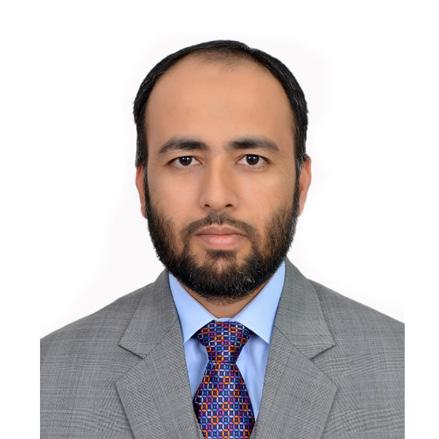


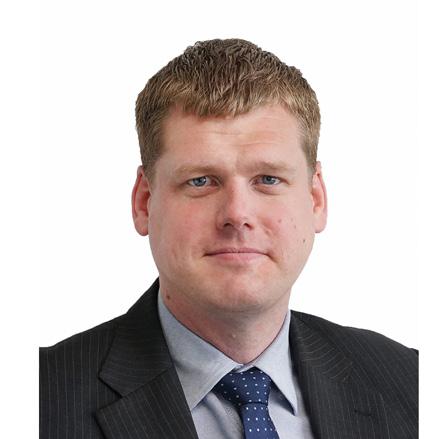


Silom Edge, 2 Silom Edge, 10th Floor, Silom Road, Suriyawong, Bangrak, Bangkok 10500 info@apuea.org
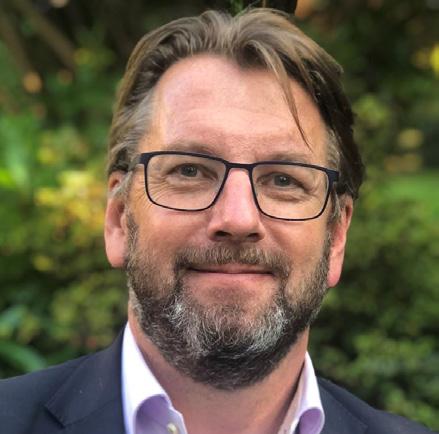 Teruhisa Oi Policy Advisor
Chen Chen China Advisor
Teruhisa Oi Policy Advisor
Chen Chen China Advisor
For more information about APUEA and how to become a member, contact info@apuea.org
www.apuea.org
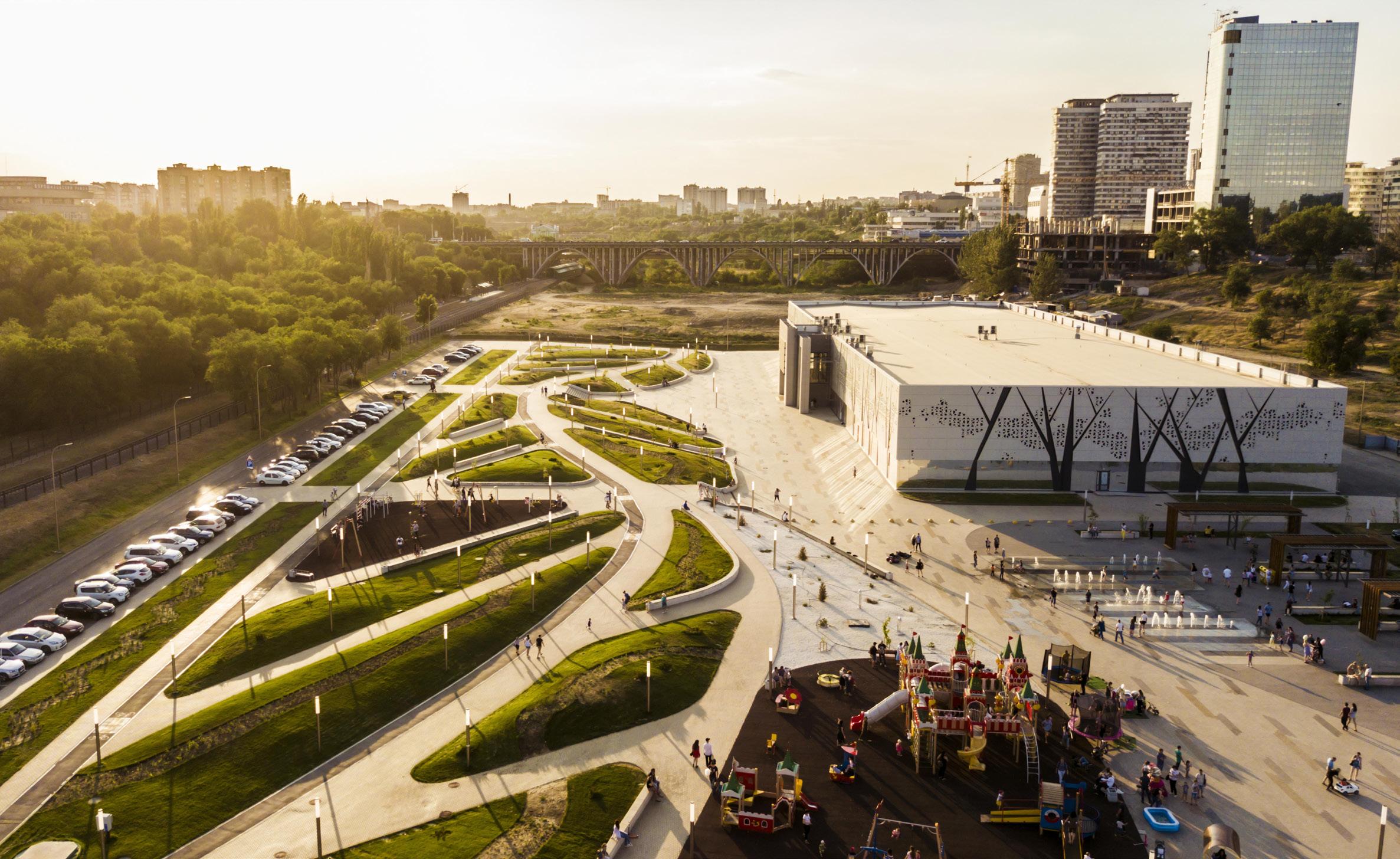
The Asia Pacific Urban Energy Association (APUEA) was launched in 2017 to promote the development of sustainable Urban Energy Systems in the Asia Pacific region. The APUEA platform promotes public and private sector collaboration to develop sustainable urban energy systems that support livable cities across the Asia Pacific region. Our membership and activities serve as an information hub to support city policymakers, program managers, and other stakeholders in the design, development, and implementation of sustainable urban energy systems. Through our activities, including APUEA events, conferences, and continuous outreach to our members, we share international and regional best practices for planning and implementing sustainable urban energy systems—including policies and regulations, business models, and technologies for implementing district heating and cooling, smart grids, energy efficiency improvements, and renewable energy systems.
The APUEA membership provides a unique opportunity to liaise with governmental agencies and important stakeholders and get access to valuable information and intelligence on urban energy developments, business opportunities, trends, and financing in one of the fastest growing energy and infrastructure markets in the world. Membership benefits include a marketing platform, newsletters, APUEA Magazine, Annual Publications, Annual General Meeting including Trade Exhibition and Direct Assistance.
The Asia Pacific Urban Energy Association (APUEA) is a platform to collect and disseminate knowledge, best practices, and tools related to the development of sustainable urban energy systems, and thereby support the development of livable cities in the Asia Pacific region.
APUEA serves a broad range of members including but not limited to utilities, manufacturers, investors, engineering companies, donor agencies and sector associations that are active in the urban energy sector. Members can choose among several membership categories, depending on their sector and level of engagement in APUEA.
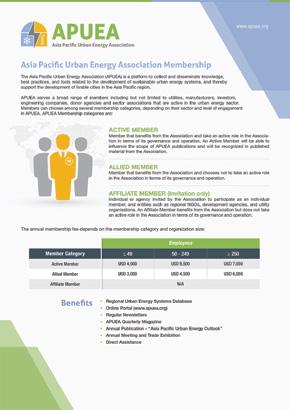

Premium membership includes an active role in the governance of the association through the APUEA Executive Committee and during the APUEA Annual General Meeting.
Premium membership also includes special recognition in APUEA publications and marketing channels, and free participation at APUEA events.
Corporate membership includes influence on the association’s activities during the APUEA Annual General Meeting, recognition in APUEA publications and marketing channels, and discounted participation at APUEA events.

Individual or agency invited by the Association to participate as an individual member; and entities such as regional NGOs, development agencies, and utility organisations. An Affiliate Member benefits from the Association but does not take an active role in the Association in terms of its governance and operation.



Client representative and multisector project management services to support your business objectives while delivering projects that meets quality, cost, and timeline.
Multidisciplinary business consulting services to empower your organization and projects while adding value and filling management and engineering gaps.




ICT solutions for District Energy and Thermal Power systems to support decision making along the entire project value chain and optimize O&M across entire system value chain.
Developing optimal energy schemes by localizing international best practises

Developing efficient energy schemes suitable to meet old and new requirements
Expanding energy systems cost-effective by introducing innovative solutions and timely implementation
Systemic technical and financial optimization while building capacity and improving efficiency, reliability and safety
Improving technical and financial performance while introducing new technologies, building capacity and adding new features


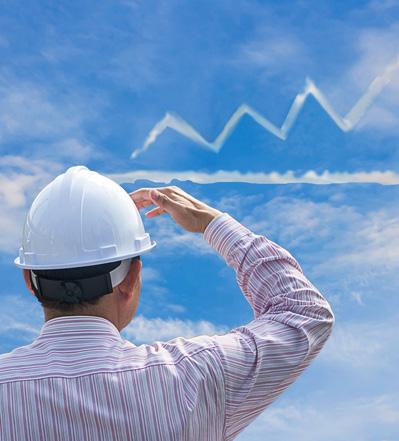
 DISTRICT COOLING DISTRICT HEATING INDUSTRIAL ENERGY EFFICIENCY MULTI-ENERGY SYSTEMS
DISTRICT COOLING DISTRICT HEATING INDUSTRIAL ENERGY EFFICIENCY MULTI-ENERGY SYSTEMS
AROUND 90 PERCENT OF TODAY’S BUILDINGS WILL STILL BE AROUND IN 2050, THE TARGET DATE FOR NET ZERO. HENCE, IT’S CLEAR THAT THE FOCUS MUST BE ON IMPROVING THE ENERGY EFFICIENCY OF EXISTING BUILDINGS AND NOT ONLY NEW ONES TO MEET DECARBONIZATION GOALS FOR 2030 THROUGH TO 2050. OUR TEAM AT ABB HAS ALREADY WORKED WITH MULTIPLE CITIES IN BUILDING EFFICIENCY PROJECTS WORLDWIDE, FROM EUROPE TO CHINA AND MONGOLIAIT IS TIME FOR EVERYONE ELSE TO FOLLOW THEIR EXAMPLE.


























City governments play a strategic role in shaping the energy transition.













































































Cities accommodate more than half of the world’s population, consume nearly 45 percent of globally available energy, and account for over 70 percent of the world’s CO2 emissions. With their high energy demand, city buildings are one of the primary energy consumers, with heating and cooling representing the largest share.
Increasing buildings’ energy efficiency is essential if we’re to meet sustainability goals and decarbonize the global economy. City governments can play a strategic role in shaping energy transition efforts in buildings but will have difficulty achieving this by themselves.
Local governments need national guidance to steer them through various stages of clean power deployment, including using renewable energy sources. City governments can persuade councils, local businesses, and civil organizations to establish microgrids and champion renewables deployment across neighborhoods.
Navigating these energy transitions will require national policy and regulatory reforms, but their successful rollout depends on the resolve of city governments. Therefore, federal policymakers should consider their vital role when designing the reforms. Progressing the clean energy transition requires two-way support.
Around 90 percent of today’s buildings will still be around in 2050, the target date for Net Zero. Hence, it’s clear that the focus must be on improving the energy efficiency of existing buildings and not only new ones to meet decarbonization goals for 2030 through to 2050. Our team at ABB has already worked with multiple cities in building efficiency projects worldwide, from Europe to China and Mongolia - it is time for everyone else to follow their example.




























































Energy inefficiencies are rife in our buildings. Many heating, ventilation, air conditioning, and refrigeration (HVACR) facilities operate at partial loads of 80 percent or less virtually all the time. Hence, if motor equipment in these buildings is only designed with a full load efficiency in mind, many savings opportunities get lost. Instead, the aim should be to design for 80 percent loads and then allow the systems to operate at loads above that with lower energy efficiency for the usually brief times of peak demand – such as in high summer. After all, the best efficiency point is typically at the design point of the application.
HVACR equipment, like pumps, fans, and compressors, takes up about 40 percent of a building’s energy consumption. Many losses in a fan wheel, for example, are because of turbulence in the airflow, and different solutions have been developed to optimize flow and avoid such turbulences. These include mechanical dampers, inlet guide wings, or fan pitch control.
Even with these optimized mechanical solutions to control flow, the system’s energy efficiency will always be best when pairing variable speed drives (VSDs) with the motors. A VSD sits between the electrical supply and the motor to regulate the incoming power, adjusting the motor’s speed. Reducing the pump or
fan speed electrically offers a substantial savings opportunity of up to 60 percent at the application level.





































Within a rigid system – where a motor is connected directly to a fan wheel –there are no efficiency losses between the motor and the fan. However, introducing a belt drive will result in losses. The challenge, therefore, is to drive requirements and legislation away from belt-driven solutions to direct drive solutions to eliminate these unnecessary losses.
Fortunately, applying high-technology VSDs to an existing installation in a building is pretty straightforward. All it requires is to rewire the motor so that the existing mains connection goes through the drive, with three wires to the drive and three to the motor.
Another option for building operators is to look at motor efficiency. Many HVAC systems still run with efficiency class IE1 and IE2 motors. Upgrading these motors to ultra-premium energy efficiency IE5 synchronous reluctance motors (SynRM) offers up to 40 percent reduced losses, compared to an IE3 motor. These motors have to be operated by VSDs, which boosts efficiency even further.
As a best practice of how energy efficiency technology can be applied

in a large city it is useful to look at Helsinki, the capital of Finland. The heating of properties constitutes more than a quarter of the city’s total energy consumption. The buildings also often require cooling. In the past, the heat generated by cooling equipment would have been released into the air, but heat pumps now make it possible to return excess heat for use in the district heating network.
Helsinki’s district heating network covers the entire city, but its district cooling network only covers its downtown area. These combined cooling and district heating (CHC) solutions are becoming more appealing to customers outside the district cooling area, as they prefer buying heating and cooling services in one package.
Oilon, the global energy technology provider, has installed high-temperature heat pumps to recycle heat energy efficiently into Helsinki’s district heating systems, a great benefit to many residents. VSDs are used to increase the efficiency of nearly all these heat pumps by controlling the variable rotational speed of heat pump compressors. Heat pumps must handle different load and temperature conditions, so the VSDs enable precise control and a large partial load capacity range.
THE EMERGING TRENDS OF DECENTRALIZATION AND DIGITALIZATION ARE A SURE WAY TO TRANSITION TO CLEANER AND MORE SUSTAINABLE ENERGY SYSTEMS. BUILDING OWNERS NEED TO TALK TO COMPANIES LIKE ABB TO HELP THEM EVALUATE THEIR BUILDINGS TO DETERMINE ENERGY INEFFICIENCIES AND PROVIDE PROPOSALS FOR SOLUTIONS.






















































The age of digitalization has undoubtedly created a paradigm shift across all businesses, including the HVACR sector. It’s not only about convenience and speed but also about improving business outcomes. By utilizing data-driven digital solutions, customers can analyze, monitor, simulate, predict, control, and optimize their energy usage and improve the performance of their electrical assets.
The Asia Pacific region has much to gain from deploying and developing smart digital solutions in district energy systems owing to the region’s diverse climate conditions. Facilitating control and planning according to forecast availability will make it possible for facilities managers and building owners to leverage the available energy faster.
Planned maintenance can also get a boost. With digitalization, facilities management providers no longer need to rely so heavily on maintenance schedules as is the case currently. Instead, they can identify a warning situation that requires attention before it becomes a critical problem, leading to significant operational savings.
Good maintenance through digital platforms can also greatly enhance indoor environmental quality. Maintenance personnel often change the filters of air handling units based on running hours, but it should instead be based on the air pollution level. Sensors can evaluate how dirty the filters are, and personnel can make changes intelligently.
Digital condition monitoring also makes it possible to assess the health of individual components, bearing conditions, or the hard disk on a SCADA automation system. Proactive warnings from sensors save time and avoid damage and costly repairs.
Taking digital integration one step further, we in ABB recently finalized the implementation of 5G networks in one of our leading factories. The primary purpose is to oversee quality monitoring and facilitate live interactions between the operator and the factory’s cloud system.
Another great example of a city walking the talk towards a more sustainable future is in Denmark. As part of the country’s goal of cutting emissions by 70 percent by 2030, ABB is supplying integrated electrical infrastructure for the world’s largest seawater heat pump in the Danish port city of Esbjerg. ABB will deploy its complete electrical, instrumentation, and control (IEC) package, motors, and variable speed drives for the pump’s powertrain.
With Esbjerg facing the UNESCO world heritage site of the Wadden Sea, selecting the right heat pump was essential. The innovative 50 megawatt (MW) heat pump system converts electrical energy into thermal energy and uses toxicologically safe CO2 as a refrigerant for the entire system cycle.
ABB’s technology will contribute to replacing the Esbjerg coal-fired combined heat and power (CHP) plant, due for decommissioning in April 2023. It will also ensure that renewables can power the entire network through connections to the offshore wind turbines in the North Sea. Apart from generating low-carbon energy from the heat pumps, the new hybrid renewable district heat plant will reduce primary energy consumption by 50 percent once commissioned.
The emerging trends of decentralization and digitalization are a sure way to transition to cleaner and more sustainable energy systems. Building owners need to talk to companies like ABB to help them evaluate their buildings to determine energy inefficiencies and provide proposals for solutions. Payback times of 12-18 months for these solutions are quite common, so considerable savings are possible for buildings that will still be around in 20 years.
The combination of low-carbon technologies and strategies with decentralized energy solutions and digital tools is already well underway, particularly in global megacities. However, these transitions come with challenges that city governments can help national governments to overcome – especially in terms of local knowledge and more fluid regulatory frameworks. Conversely, national governments have an equally
supportive role to play, mainly by involving cities in planning processes early and creating the right legal frameworks for them.
The built environment in cities has enormous potential to accelerate decarbonization and create a more sustainable urban environment for its citizens. But the time to act is now.
ABB encourages all stakeholders to join the Energy Efficiency Movement to bring about a comprehensive reduction in energy consumption. More details are available here:







































https://www. energyefficiencymovement. com



ABB (ABBN: SIX Swiss Ex) is a leading global technology company that energizes the transformation of society and industry to achieve a more productive, sustainable future. By connecting software to its electrification, robotics, automation and motion portfolio, ABB pushes the boundaries of technology to drive performance to new levels.
With a history of excellence stretching back more than 130 years, ABB’s success is driven by about 105,000 talented employees in over 100 countries. www. abb.com

“DERMS – A DISTRIBUTED ENERGY RESOURCE MANAGEMENT SYSTEM - IS THE KEY TO UNLOCKING THE RENEWABLE ENERGY POTENTIAL OF COMMUNITIES’ RESIDENTIAL DERS. WITHOUT REQUIRING MAJOR INFRASTRUCTURE UPGRADES, UTILITIES CAN TODAY INSTALL A TOOL THAT MANAGES THE RAPID ADDITION OF RENEWABLE ASSETS. A DERMS GIVES GRID OPERATORS A COMPREHENSIVE VIEW OF EVERYTHING THAT’S HAPPENING ON THE GRID, AND CAN BALANCE POWER BETWEEN INTERMITTENT ASSETS, ENERGY STORAGE, AND LEGACY POWER PLANTS.


Distributed energy resources (DERs) like residential solar panels are a great way for homeowners to reduce their carbon footprint and the energy they draw from the grid. Consumer DERs can also benefit utilities, as owners of PV panels can augment the utility’s power supply by putting excess power into the grid.
However, DER assets are only advantageous to both parties if utilities can manage their contribution to the grid safely and consistently. Solar PV and EV chargers can disrupt grid stability if utilities can’t accommodate spikes in power generation or consumption. To effectively manage DERs, utilities need to employ innovative clean energy tech that can seamlessly manage and integrate various resources from DERs to traditional power plants.
MANAGING these resources while minimizing grid disruption and controlling for intermittent power supply is a huge challenge, and a grid that cannot effectively support DERs is essentially wasting clean energy. Utilities may think accommodating these renewable assets and making full use of their clean energy requires major infrastructure upgrades. However, cost-efficient software solutions exist now that utilities can easily integrate with legacy grids to balance both renewable assets and legacy fossil fuel power plants.
DERMS – a distributed energy resource management system - is the key to unlocking the renewable energy potential of communities’ residential DERs. Without requiring major infrastructure upgrades, utilities can today install a tool that manages the rapid addition of renewable assets. A DERMS gives grid operators a comprehensive view of everything that’s happening on the grid, and can balance power between intermittent assets, energy storage, and legacy power plants.

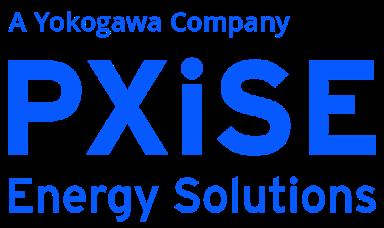
has partnered with several utilities around the world to help manage their energy assets with a DERMS solution. One such project is in the remote town of Onslow, Australia, where utility Horizon Power needed a way to integrate a broad array of customer DERs into a grid that includes fossil fuel generators. This isolated community lacks a connection to a larger power grid, which makes power management with a high number of intermittent renewables more challenging.
HORIZON POWER paired a state-of-the-art DERMS alongside a microgrid controller from PXiSE that uses two-way, sensor-


based technology to monitor the grid in real time, mitigating disturbances and balancing variable solar generation, energy storage, and customer demand.
With 260 customer solar PV resources providing 2.1 MW generating capacity (and capacity for an additional 200 kW), the project provided Horizon Power with the tools needed to manage Onslow’s diverse energy assets. The project also demonstrated that the combination of a microgrid controller and DERMS can help a community run entirely on fossil-free DERs. Earlier this year, in the world’s first known instance of solar-plus-batteries supplying 100% of a community’s power, Onslow was powered without the use of any fossil fuel or hydropower-based systems for 80 minutes.
THE LANDMARK EVENT in Onslow proves that a DERMS can manage DERs with a degree of precision that eliminates grid stability concerns and moves communities closer to being able to operate entirely on renewable energy assets. As communities seek to meet their climate action goals, DERs will continue to increase. DERMS technology available today can help utilities ensure their grids are not only prepared but also optimized for the benefits of the clean energy revolution.

Yokogawa provides advanced solutions in the areas of measurement, control, and information to customers across a broad range of industries, including energy, chemicals, materials, pharmaceuticals, and food. Yokogawa addresses customer issues regarding the optimization of production, assets, and the supply chain with the effective application of digital technologies, enabling the transition to autonomous operations.
Founded in Tokyo in 1915, Yokogawa continues to work toward a sustainable society through its 17,000+ employees in a global network of 122 companies spanning 61 countries.
For more information, visit www.yokogawa.com
“DHC MAY RESULT IN UP TO 50 PER CENT REDUCTION IN ENERGY CONSUMPTION, 50 PER CENT REDUCTION IN CO2 EMISSIONS AND REFRIGERANT FLUID LEAKS,”
“IT
SUPERMARKETS, UNIVERSITIES –IN ONE SYSTEM. THIS DIVERSITY REDUCES THE PEAK HEATING AND COOLING DEMAND, AS NOT ALL BUILDINGS HAVE THEIR PEAK AT THE SAME TIME, AND RESULTS IN SMALLER PLANT. IT IS POSSIBLE TO REDUCE THE INSTALLED CAPACITY BY UP TO 30 PER CENT.”
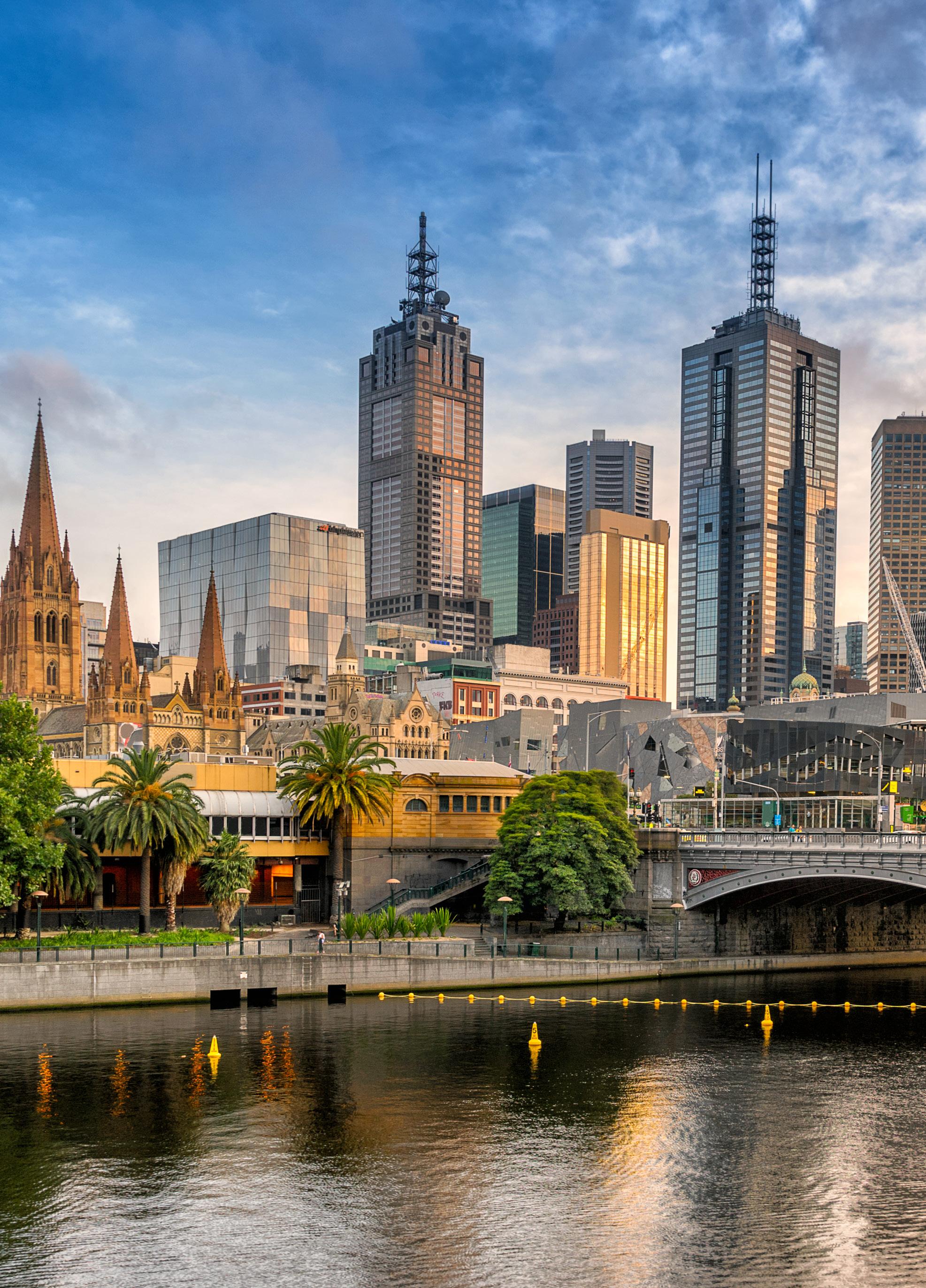
MAY COMBINE VARIOUS END - USERS OF DIFFERENT ACTIVITIES – OFFICE, RESIDENCES, SHOPPING CENTRES,
District heating and cooling could offer an important pathway to decarbonisation – and one of the biggest barriers to its uptake might simply be our mindset, writes Mark Vender.
We think nothing of paying for electricity that is generated elsewhere and then delivered via the grid to our home or office. We routinely use other shared services such as internet, water and sewage, all of which rely on a larger infrastructure. When it comes to heat and coolth, however, we cling to the notion that these must be generated onsite, by privately owned equipment.
Perhaps there is a better way.
District heating and cooling (DHC) uses local energy networks to provide heating and cooling to buildings in a district. They do this by supplying hot water or steam for heating systems, and chilled water for air conditioning.
The district may comprise a small group of buildings on a university campus. Or it could be much larger, as in Denmark, where about two-thirds of residential dwellings are connected to district heating.
A recent event in Melbourne organised by energy company Engie and the Asia Pacific Urban Energy Association (APUEA) explored DHC and the opportunities it presents.

APUEA executive director Peter Lundberg believes that DHC has a major role to play in decarbonising the built environment.
“DHC may result in up to 50 per cent reduction in energy consumption, 50 per cent reduction in CO2 emissions and refrigerant fluid leaks,” he says.
“It may combine various end-users of different activities – office, residences, shopping centres, supermarkets, universities – in one system. This diversity reduces the peak heating and cooling demand, as not all buildings have their peak at the same time, and results in smaller plant. It is possible to reduce the installed capacity by up to 30 per cent.”
Thermal storage systems can play a complementary role. Lundberg says that these can further reduce the peak mechanical capacity of DHC systems, and can help increase the use of renewable energy by storing chilled water produced with intermittent renewable electricity.
Other benefits of centralised systems include lower operation and maintenance costs, more space in individual buildings, and reduction of urban heat island effects. They can facilitate multiple production plants. And they can use sources of “free cooling” including, rivers, lakes, geothermal, and also waste energy where available.
One of the attendees at the Melbourne district energy event was Michael Snow, associate director, carbon neutral and university infrastructure at RMIT University, and a proponent of DHC technology.


Snow cut his teeth in the energy industry in cogeneration, during its heyday in Australia. Although the systems were effective at providing electricity and hot-water, a lot of heat was wasted. Frustrated by this, Snow and his colleagues looked to the European district systems for ideas.
They noted some big differences between Europe and Australia. Whereas our focus was on electricity loads, in Europe they focused more on heat loads.
“They view energy fundamentally differently,” says Snow. “We look at a cooling tower as something you need for a chiller. They look at a cooling tower, aghast, as to why would you waste that energy?”
Some of this can be traced right back to the oil crisis of the 1970s.
“Energy has been historically very cheap in Australia, and we weren’t affected by the oil price shocks to the degree they were” says Snow. “We had some lines at the petrol station; they had fundamental crises with their energy system. So they rethought things.”
Despite the differences, some larger projects did reach various states of completion in Australia.
In the early 2010s in Melbourne, a $290m project initiative sought to revitalise central Dandenong with a seven-hectare mixed-use development boasting strong sustainability credentials. Key to this was the Dandenong Precinct Energy Project (PEP) – a distributed energy cogeneration plant that provided an effective way for businesses in central Dandenong to access lower carbon electricity and thermal heating and cooling.
Unfortunately, technical and commercial challenges meant the project goals were
not achieved. While connection to the network was strongly encouraged during the development-approval process, it could not be mandated. This led to a situation where developers refused to connect unless energy could be provided at significantly lower prices, which wasn’t possible due to the relatively low energy density of the load on the network during early stages of the precinct’s build-out.
In Sydney, the Decentralised Energy Master Plan Trigeneration 2010–2030 sought to connect 65 per cent of all commercial floor space, 50 of all retail floor space, and 30 per cent of all residential floor space within the City of Sydney to low-carbon electricity and zero carbon heating and cooling.
But the project never came to fruition. One issue was the idea of digging up major streets in the CBD to lay pipework, declared unfeasible in some cases.
“But since the project was shelved they have installed a major light rail network, which was incredibly disruptive to the city,” says Snow, “so installation of major new infrastructure like a DHC would be viable given the right commercial circumstances.”
Although these projects didn’t succeed – and although cogeneration and trigeneration later fell out of favour for sustainability and economic reasons – the DHC concept remains attractive.
“Whether you have cogen in it, or hydrogen fuel cells, chillers, heat pumps, or the next flux capacitor, it doesn’t really matter,” Snow says. “It’s the energy centre and the pipework is the reticulation. That’s how you get the energy around.”
As well as the floorspace that can be saved by having shared plant in another location, DHC may allow new buildings to be occupied more quickly.
“In a 20-storey building, before you can occupy level one, you’ve got to build out all 20 floors and then install your plant on the roof and commission it and get it running so that you can condition the space below,” Snow explains.
“Now, what if you were to use a district plant that’s got pipes in the ground ready to go right there at your door when you build the basement? You build the energy-transfer station, and then the pipe just grows with the building and you can basically occupy the building as you’re going up.
“That’s a huge benefit that just doesn’t factor into our thinking at the moment.”Snow says DHC could also help us along the road to electrification.
“Does it make sense to change every single boiler in every single building?” he says. “Or does it maybe make sense to build one new building, fit that out and then go and hook up all these new buildings?
“I think there’s a big opportunity in district systems to take on that challenge.”
Lundberg says the Melbourne DHC event revealed the state of play for DHC systems in Australia.
What it showed was that while broad uptake may be a way off, universities are adopting the technology.
“Universities have ambitious net zero targets in Australia, and it was encouraging to see that several universities attended the event and shared their stories,” says Lundberg. “They are exploring DHC as a technology that can be implemented in brownfield campuses to provide energy-efficient heating and cooling, reduce energy use, and integrate with the renewable technologies.
Developers of greenfield campuses also talked about the opportunities of integrating DHC in their campus masterplans.
“This was a first event on this topic, and with the positive feedback, we believe that more similar events should be held in the future to capture the potential of DHC systems at universities in Australia.”
This
Go to www.theecolibrium.com

UNIVERSITIES HAVE AMBITIOUS NET ZERO TARGETS IN AUSTRALIA, AND IT WAS ENCOURAGING TO SEE THAT SEVERAL UNIVERSITIES ATTENDED THE EVENT AND SHARED THEIR STORIES,” SAYS LUNDBERG. “THEY ARE EXPLORING DHC AS A TECHNOLOGY THAT CAN BE IMPLEMENTED IN BROWNFIELD CAMPUSES TO PROVIDE ENERGY - EFFICIENT HEATING AND COOLING, REDUCE ENERGY USE, AND INTEGRATE WITH THE RENEWABLE TECHNOLOGIES. DEVELOPERS OF GREENFIELD CAMPUSES ALSO TALKED ABOUT THE OPPORTUNITIES OF INTEGRATING DHC IN THEIR CAMPUS MASTERPLANS.article was originally published in the November 2022 edition of Ecolibrium magazine, the official journal of AIRAH. It is reprinted with permission, and may not be reproduced without express consent from AIRAH.

(Environmental, Social, and Governance) is a framework that helps stakeholders understand how a company is managing risks and opportunities related to environmental, social, and governance criteria. Looking at ESG from a plant management’s perspective: Environmental includes energy, water and waste. Social covers safety, first and foremost. Governance consists in complying with regulations and best practices, as well as communicating with stakeholders.
Digital technology suppliers have rushed into the ESG trend. Thanks to the relatively low barrier to entry, many IoT-turned-Digital Twin players have now become ESG specialists and updated their brochure accordingly. Challenges, limitations, disillusions are already visible. However, more than a fad or a feel-good exercise, ESG can have a lasting positive impact on the enterprise and its stakeholders. More than a business opportunity or a gimmick, digital technologies can help in the implementation of ESG.
Let us explore typical real-life situations: The facility manager at a leading automotive OEM in East China was disappointed when he realized the ESG platform deployed by their group was simply capturing energy consumption meters value and applying a formula to calculate CO2 equivalent. Now that the easiest has been done, he is looking for a solution to track improvement actions, enforce good operation & maintenance habits, both for in-house workers and facility management contractors.
An Italian manufacturer experienced repeated fires, luckily with only minor damages. After mandatory reporting to the local government, investigations were carried out, resulting in corrective actions. During a follow-up visit, the auditors found that many actions had not been completed, despite paper documentation saying they were. After receiving a warning, the company realized such critical activities were not managed by its corporate IT system.
The industrial director of a European construction material producer in Asia decided not to pursue the implementation of a so-called Digital Twin for energy management. Instead, he built the same functionality with existing sensors, PLC and Business Intelligence tools. The downside was that his company did not benefit from the positive ESG-themed coverage usually associated with signing with this supplier, very active on social media.
In the first two examples, the digital solutions did not provide useful support in managing risk. In the third example, the client concluded that for such limited usefulness, they could build their own system in-house.
MAINTENANCE HAS A MAJOR INFLUENCE ON CARBON EMISSIONS, FIRST THANKS TO ITS IMPACT ON ENERGY CONSUMPTION, SECOND IN TERMS OF THE EMBODIED CARBON IN THE COMPONENTS AND CONSUMABLES USED. ONSITE ENERGY FACILITIES, SUCH AS THE PV PLANT, AND MONITORING EQUIPMENT, SUCH AS SENSORS, THEMSELVES REQUIRE COMPLEX MAINTENANCE TO OPERATE AS DESIGNED.
ESG often focuses on direct and indirect greenhouse gas emissions, considered a good proxy for environmental compliance. The carbon footprint methodology is used to estimate the greenhouse gases emissions, and to suggest actions to reduce these emissions. It looks at various greenhouse gases, measured in CO2 equivalent. The ISO 14064-1:2018 standard, part of the ISO 14000 environmental series, specifies principles and requirements for the quantification and reporting of greenhouse gas emissions and removals. Carbon footprint scope 1 and 2 refer to emissions from the plant facilities and the energy consumed (excluding the supply chain).
Contributing activities in the plant include the use, maintenance, repair, replacement, refurbishment of facilities and equipment, as well as operational energy and water usage. Energy consumption is the single biggest contributor and most CO2 emissions can be computed with a simple formula: energy consumption (kWh) x energy carbon content (kgCO2eq/kWh). The carbon content depends on the electricity mix, which leads companies to make contractual arrangements with utilities and to develop their own renewable energy capacity such as rooftop PV power plants. Energy consumption can be optimized through systematic analysis, improvement, and monitoring.
This energy optimization exercise results in a technical action plan that may include plant modifications, new operation and
maintenance routines. Maintenance has a major influence on carbon emissions, first thanks to its impact on energy consumption, second in terms of the embodied carbon in the components and consumables used. Onsite energy facilities, such as the PV plant, and monitoring equipment, such as sensors, themselves require complex maintenance to operate as designed.

HVAC is typically the largest system in terms of energy consumption and carbon emissions, often contributing over 50% of emissions. The energy efficiency improvement plan may include building modifications (for example insulation), right sizing the HVAC equipment, setup of sensors for continuous monitoring, and O&M activities such as setting different temperature setpoints, repairing damaged equipment, identifying and fixing leaks, inspections etc. Lubrication and filter cleaning, as untrendy and unsophisticated these activities may appear, are two major contributors to energy inefficiencies: double digit energy savings from adequate routines are not unheard of.
Far from being magically solved by technology, the ESG improvement plan relies on people, engineers, technicians, operators in the plant, managers to make decisions based on facts and figures. Digital initiatives in this field stubbornly focus on monitoring consumption because it is needed but also because it is relatively easy to achieve. In fact, companies did not wait modern Digital Twins with 3D modeling to install automated
meters and collect energy data. IoT vendors, once clamoring that “predictive maintenance is a low-hanging fruit” only to realize that it wasn’t so simple, often settled down to automate utility meter reading. Some have now repurposed the exact same solutions as “ESG”, a clever marketing move!
Brose Wuhan, mechatronics components supplier to automakers, did not wait for technology vendors. Facing strong market demand, busy installing new production lines, the company’s General Manager hired consultants to conduct energy and maintenance audits. An action plan was quickly put in place by Siveco China. The plant’s technical data were digitalized, based on which failures and their impact were systematically analyzed. Lubrication and preventive maintenance routines were established. The system monitored the execution of the plans. This continuous feedback loop between plan and action resulted in a 36% reduction of the electricity bill after 6 months. ROI was obtained well within a year. How about the energy meters? They were recorded independently
in the existing SCADA system. Equivalent CO2 emissions can be easily computed in Excel at the end of the month.
AstraZeneca took the opportunity of a new wastewater plant in Wuxi, China, to deploy best sustainability practices. A system dubbed “Digital Twin for Operation & Maintenance” was setup before plant startup, establishing a feedback loop between the plant and its outsourced service team (using mobile devices to manage their daily work), allowing AstraZeneca to make decisions to control costs and risks. The bluebee® system ensures compliance and traceability of O&M on a critical environmental asset, the pharmaceutical wastewater treatment. While regulatory compliance and public safety are the top priority, the AstraZeneca project director also listed energy savings, emission reduction and lower manpower cost thanks to the digital solution. Fully cloudbased, the system provides both monitoring and display functions, as well as managing the actual daily operation and maintenance work.
According to the US Dept of Energy: “O&M measures cost about 20 times less and achieve roughly the same energy savings as energy efficiency upgrades.”
New construction is the ideal time to build a comprehensive digital solution for ESG. For the massive Integrated Waste Management Facilities, a strategic infrastructure currently under construction in Hong Kong, the special administrative region’s Environment Protection Department has specified a Digital Twin for O&M covering maintenance, documentation, environmental compliance, energy efficiency, regulatory reporting. Featuring an embedded BIM model, the system collects data from 9 different subsystems including DCS, BMS, OMCS, ATCS, AMDAC etc. Siveco Hongkong was awarded the contract to deliver the system based on its Coswin 8i maintenance system and bluebee® risk prevention solution. Having successfully passed design approval, the project follows the plant construction schedule, with FAT planned for mid-2023 and commissioning mid-2024.
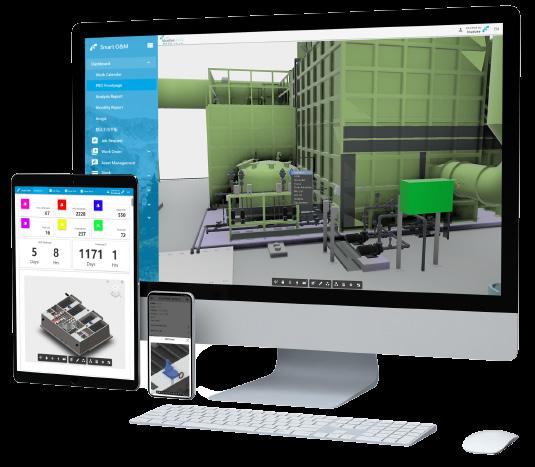
According to the US Dept of Energy: “O&M measures cost about 20 times less and achieve roughly the same energy savings as energy efficiency upgrades.” As the concept of ESG is of course not limited to greenwashing and marketing, ESG projects and the supporting digital systems cannot be limited to just monitoring and reporting. It is the technical improvement actions taken (or not) in the plant that will ensure actual improvements in ESG. They must and can be managed in a digital solution that will not only monitor energy meters and other sensors (which traditional SCADA could already achieve), not only display KPIs in a beautiful dashboard (which many BI solutions can do), but also and more importantly manage interrelated technical data, help analyze failures and their impact in a systematic manner, define and track corrective and preventive actions including routine maintenance. This feedback loop between work execution and strategy is what will enable continuous improvement, while acting as a brilliant showcase of good ESG practices to all stakeholders.
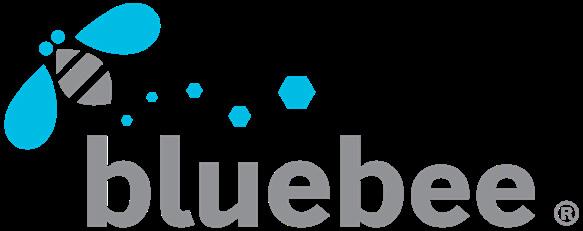
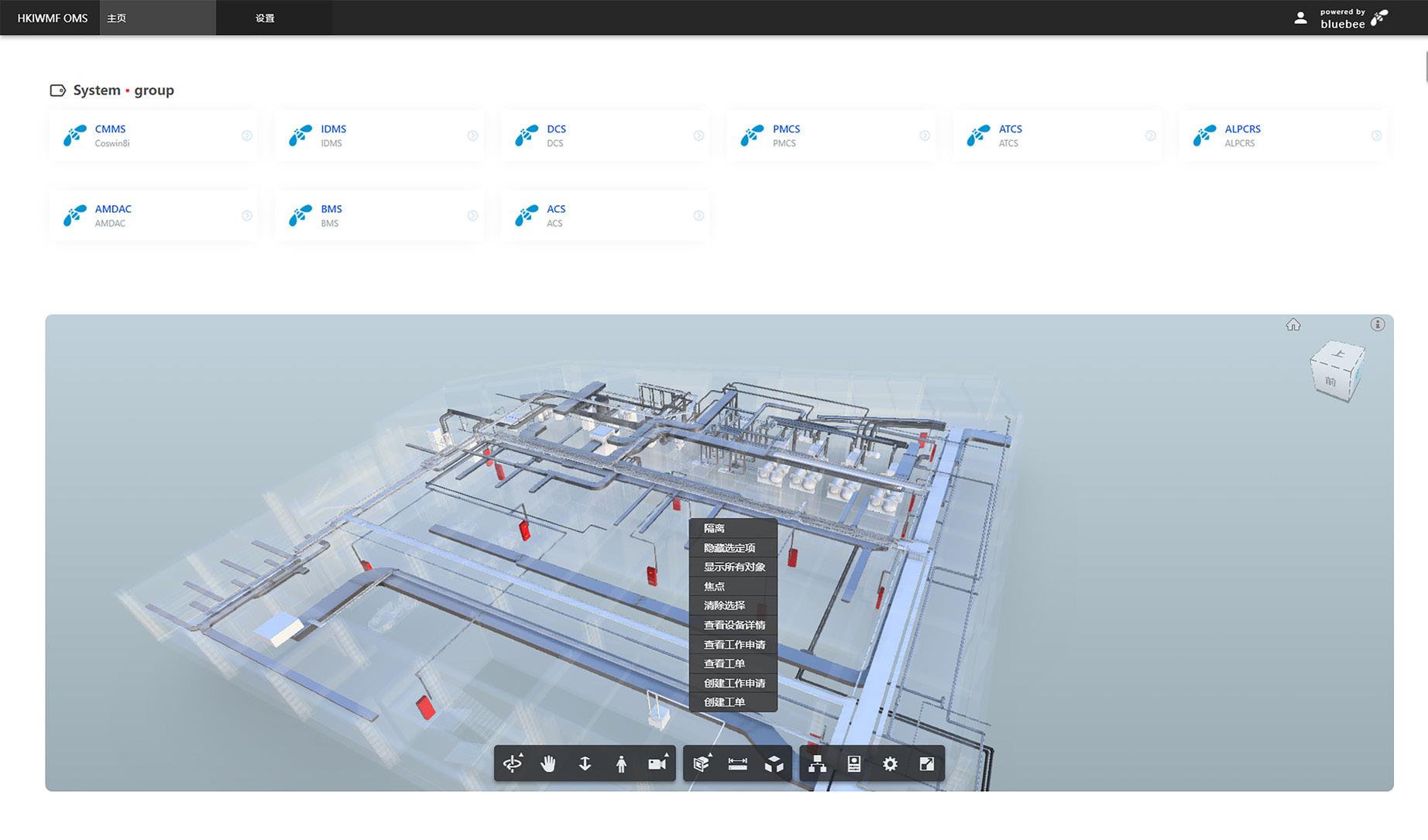
 BY APUEA
BY APUEA
“WE ARE THE EUROPEAN ASSOCIATION, PROMOTING SUSTAINABLE DISTRICT HEATING AND DISTRICT COOLING SOLUTIONS IN EUROPE AND COLLABORATING WITH INTERNATIONAL PARTNERS. OUR MEMBERS INCLUDE NATIONAL ASSOCIATIONS, WHICH ARE OUR PRIME MEMBERS, BUT ALSO DISTRICT ENERGY UTILITIES, EQUIPMENT MANUFACTURERS, STARTUPS, AND UNIVERSITIES.

One of APUEA’s supporting partners since the launch in 2017, and who has been working with us to develop and execute activities by providing advising support as well as co-hosting events is the Brussel-based organization Euroheat & Power (EHP). To learn more about EHP’s goals and activities, their view on District Energy developments in Europe and globally, and why District Energy is an important solution to decarbonizing heating and cooling, we had a conversation with Aurélie Beauvais, who is the Managing Director of EHP. Aurélie also shared her thoughts on what can be done to speed up the Development of District Heating and Cooling systems by identifying existing barriers and how they could be overcome.
My name is Aurélie Beauvais, and I have been working with energy and European affairs in Brussels for the past ten years. During my career, I have covered a large variety of topics. I started in the French Union of Electricity, with a strong focus on carbon markets, electricity market design and capacity-market topics. Then I moved to the Solar sector in 2017, where my work focused on Renewable Energy and climate policies. Since the 16th of April 2022, I have been the new
Managing Director at Euroheat & Power. We are the European Association, promoting sustainable District Heating and District Cooling solutions in Europe and collaborating with international partners. Our members include national associations, which are our prime members, but also District Energy utilities, equipment manufacturers, start-ups, and universities.
Our activities are organized according to our key priorities: to serve our members in three areas in particular i) Influence, ii) Knowledge, and iii), Business Opportunities. When looking at influence, the goal is to ensure that the European regulatory framework acts as an enabler for our industry to thrive, meaning decarbonizing and growth and remaining a cost-efficient solution for European consumers. To realize this, we have a dedicated committee called the Enerpol Committee, which works primarily with national associations and active companies to define our position and then convey it to European policymakers. We also have an annual policy conference in Brussels where we offer the opportunity to meet with policymakers and discuss how to best support the District Energy development in the 27 markets we have.
The second pillar is knowledge, where we have two activities. The first is the DHC platform, a knowledge hub where we engage with EU funded District Energy projects, help our members go

into project consortiums and disseminate the results of major DHC research and innovation projects. Euroheat & Power is the energy association with the largest EU project portfolio, and this is something that we are proud of. Our objective is to keep our sector up to date with the latest innovation trends and support start-ups to obtain funding and develop their technology. We also develop frameworks, regulatory sandboxes, and other tools for the uptake of innovation. This year we have also launched a market intelligence department, and we publish an annual publication called the District Heating and Cooling Market Outlook. In the outlook, we look at District Energy market prospects, mostly in Europe but also globally, for example, in Japan. This annual outlook aims to provide a detailed District Heating and Cooling market overview. The market and intelligence department are also working on proposing webinars on various topics and markets with our members.
The third pillar, Business Opportunities, includes two main activities, the first is our congress, which goes from being held every two years to being an annual event. The congress is the central meeting point for the industry, we have over 350 participants, and includes B2B matchmaking and sessions focusing on market prospects and technology. This event is the biggest business opportunity we provide to our members, including participation and showcasing their products and solutions. During the year, we also host several smaller events in Brussels focusing on policy and project-related activities. We also host 5-10 webinars on various topics like policy and technologies.
To be useful to your members, you must have a thorough knowledge of the market where you operate, and good connections with local policy makers. Our primary focus is regulations in European Union countries and EEA countries, particularly Norway and Iceland. Of course, the energy transition is global, and many of our members operate globally, so we also think it is vital to work and collaborate with international partners, including the Asia Pacific Urban Energy Association (APUEA).
Board of Directors. Smaller companies and start-ups typically focus more on business development activities. Usually, they are very active in our events, where they can showcase their business and develop a network of partners. They are also very active in our DHC platform, where they focus on participation in European projects to get funding for the projects they are developing.
CAN YOU DESCRIBE THE BENEFITS OF DISTRICT ENERGY AND HOW IT PLAYS A VITAL ROLE IN DECARBONIZING HEATING AND COOLING IN EUROPE AND ELSEWHERE?
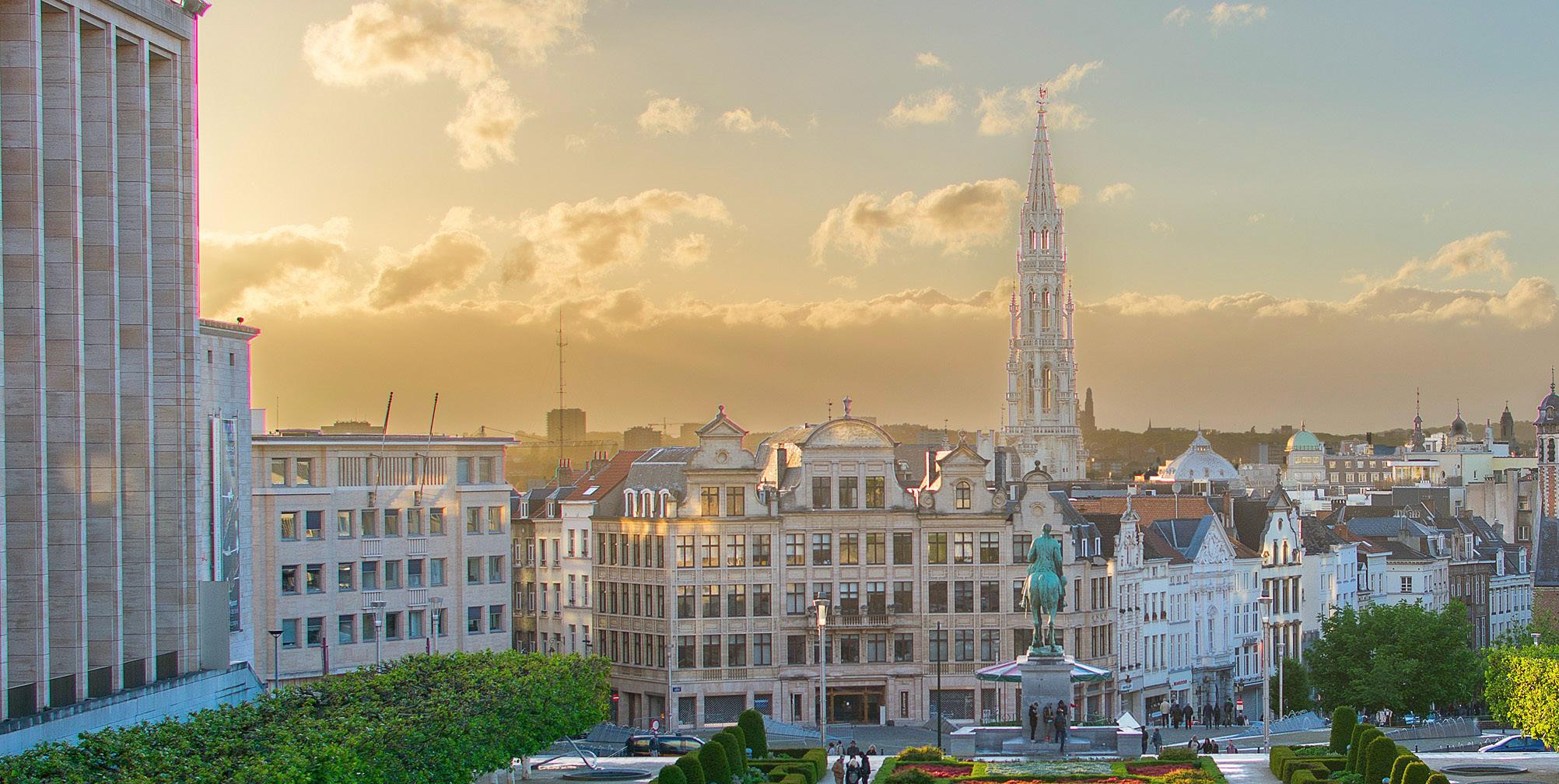
to-heat technologies like heat pumps or e-boilers. Being a local technology reduces the risk of dependence on global energy markets. In the current energy crisis, we have seen that the price increase in areas with District Energy networks has been much lower than in areas that use gas and electricity. This benefit has always been there but is really obvious right now.
We have over 140 members, and how they will engage with us depends on the type of member and their needs. For example, European national associations are our prime members and contributors and are all part of our Board of Directors. They are also automatically a part of our energy policy committee, the Enerpol committee, where we work on policies and incentives to support District Energy developments in the different markets. Large companies typically use their public affairs, sales, and marketing departments to work with us, for example, taking place in the Enerpol committee and exhibiting and sponsoring our events. Six of our larger member companies are also members of the
The beauty of District Energy technology is its ability to create a multi-energy system, which can rely on various sources and is unique and adapted to local conditions. This ability is a crucial advantage as we propose a transition passway for regions and cities that are very different in size, energy consumption profile, and resource availability. The versatility that District Energy systems offer is a gateway to integrating Renewable Energy. We know that the areas in Europe with the highest penetration of District Energy systems also have the highest share of Renewable Energy in their heating and cooling systems. These areas can utilize the local renewable resources for heating and cooling, for example, bioenergy, geothermal, solar thermal, and power-
Another advantage we see more and more is that District Energy systems can have an important function in balancing the power grids as more and more renewable electricity is installed. We call this system integration which also increases the resilience of our energy systems. And with an increasingly growing rate of electrification in our cities and regions, thermal energy networks can add flexibility by producing electricity through co- generation and absorbing more intermittent renewable electricity when available. District Energy networks can function as thermal energy storage both from day to day and also as seasonal storage. Thermal energy storages are 100 times cheaper than battery energy storage. District Energy systems can offer a cleaner, more secure, and more efficient method for heating and cooling, and I don’t think the energy transition can be achieved without District Energy systems.
HOW MANY MEMBERS DOES EHP HAVE, AND HOW DO THEY USE EHP ACTIVITIES IN THEIR BUSINESS?
DO YOU HAVE ANY RECOMMENDATIONS ON ACTIVITIES THAT CAN HELP SPEED UP DISTRICT
I think awareness and communication are critical because technology already exists today, but the lack of awareness is quite stunning. Most of the time, when presenting in front of policymakers, I have to start to explain what District Energy is, and I think we need to come to a point where we don’t have to explain the technology anymore. We, of course, understand that the technology is complex and that it is part of our work as international trade associations to simplify this and create a narrative which makes it easier to convey what District Heating and Cooling systems are all about.
There are also finance and regulatory instruments that can help; in particular it would be helpful to have stronger requirements for local authorities to properly assess their local heat resources and use them wherever it makes sense economically and climate-wise In Europe, we are now thinking to introduce mandatory heating and cooling planning for cities with a population larger than 35000.
Cities hold 75% of our population and most of our building stock, and it is here we can reduce fossil fuel dependency by utilizing local resources for heating and cooling. We must start a discussion on mandatory deployment of district energy networks for some areas where it’s proven to be the most efficient and environmental solution, and where
local resources like waste heat can be utilized. There is also a lack of skill and capacity building in cities that needs to be addressed. I think there is a need to train cities in Europe and elsewhere to see the possibilities and benefits District Energy can offer and how they can realize their potential.
One important barrier is a lack of awareness, which can be addressed by a consistent and important effort of communication and simplification from the sector. District Energy systems are still perceived by policy makers as an old technology, whereas it is one of the most adaptable and innovative solution available to decarbonize heating and cooling in cities. We need to create a “hype” for Sustainable heating and cooling which is similar to the hype for hydrogen, except that we can already deliver concrete, innovative and efficient projects. Cities are already very proud of their DHC systems, and we should make it possible for them to shine internationally.
Another barrier, is the unfair competition with individual heating solutions for buildings which are the main competitor to District Heating systems in Europe. Even though most individual solutions, such as fossil-boilers, are inefficient and polluting, they are cheap to buy and operate. People are used to this setup and most of them are not equipped to rethink their heating system by themselves, which makes it a major barrier to implementing District Heating in European cities.
One way to address this and push the decarbonization of buildings in Europe is to use carbon pricing, but this isn’t easy, especially with the increased energy prices caused by the war in Ukraine. The last thing consumers want right now is higher energy prices. These discussions are not new, they have existed for more than a decade, but the bottom-up policy to protect consumers and enable them to effectively renovate their home and decarbonize their heating and cooling are still missing. This is why from our perspective, mandatory local heat planning and ore prescriptive regulation on District energy deployment could be more effective.
With the energy crisis, we have, on the one hand, a strong push for growth but also an ultimatum for transformation and really switch away from fossil fuels. It will require an effort, but that is not a bad thing, and we have a saying in Europe today that the current situation is the perfect “energy storm” for developing smart and sustainable District Heating and cooling systems.

The potential in Europe and globally is huge, first because the resources for District Heating and Cooling are so untapped. As we say, we are the underdog in the energy transition, and I think these solutions will be more and more recognized as cities look for ways to support the energy transition. It will not be easy to reach carbon neutrality in 2050. In Europe and globally, heating and cooling stand for half of the energy demand and about 90% is based on fossil fuels. There is a need to replace fossil fuels with other sources like, for example, waste energy. In fact, waste heat recovery from industries, public buildings, and metros could cover 25% of the future District Energy supply in Europe. Renewable electricity also has excellent potential and will become abundant and get cheaper and cheaper, leading to that power-to-heat solutions will become very cost-efficient.
Then we also have renewable heat like thermal energy and solar thermal that has great potential in the future. In Europe, the demand will grow, and we have huge resources we can tap into, and District Heating can supply up to 50% of the European heat demand in 2050 compared to 12% today. This is the technical potential, and if we look at the implementation potential, I believe the potential is above 30%. If we look at Germany, which has a bit complex energy market, they forecast that in 2045, District Heating will represent 26% of their heating supply.
Germany has great potential because they are very late in its heating transition. In Germany, there are more than 20 million gas boilers that need to be phased out, and it will not be possible to replace all of them with heat pumps.

Germany has great potential because they are very late in its heating transition. In Germany, there are more than 20 million gas boilers that need to be phased out, and it will not be possible to replace all of them with heat pumps. But Germany is already a large market with more than 11 million citizens supplied by District Heating. Poland is also an exciting and huge market, with more than 20% of the population connected to District Heating systems. The challenge here is to decarbonize these systems. Other countries with potential include the Czech Republic and countries exposed to high gas prices. In general, system integration has a large potential in Europe, and in countries with a high degree of electrification, like, for example, Norway, where District Heating is needed to balance the power grid. Another driver that is relevant everywhere is the growing cooling demand. In Europe, we are experiencing an increasingly hot climate, and if heating is the “elephant in the room” in the energy transition, cooling is the “elephant in the waiting room”. The last driver for District Energy growth I want to mention is the interesting synergy with islands. Islands have a large population globally and a bit complicated energy systems. In many islands, deep see District Cooling systems have great potential to supply clean energy to its citizens.
Yes, we have two flagship events next year. The first one is the Euroheat & Power Congress that will be held in Torino between the 22-24th of May. I think it’s going to be a good event, the market is picking up steam now, and there is a lot of excitement in the sector at the moment. The congress will look at technology and market development and ensure that businesses can meet. We will also host the Global District Energy Climate Awards during the congress. The second event is our policy conference, which will be held in Brussels in November 2023. During the event, we will present a set of policy recommendations and regulatory and financial instruments to spur the development of smart and sustainable District Heating and cooling in Europe. The idea is to hand over these proposals to policymakers as a blueprint for heating and cooling regulation. I think this event will also be very interesting for the sector.
Euroheat & Power is the international network for district energy, promoting sustainable heating and cooling in Europe and beyond.
We are a non-for-profit association headquartered in Brussels, Belgium, which unites the district energy sector. Our members come from over thirty countries around the globe and include national district heating and cooling associations, utilities operating district energy systems, industrial associations and companies, manufacturers, universities, research institutes and consultancies active in the sector.

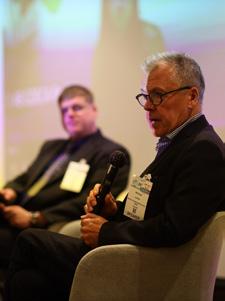
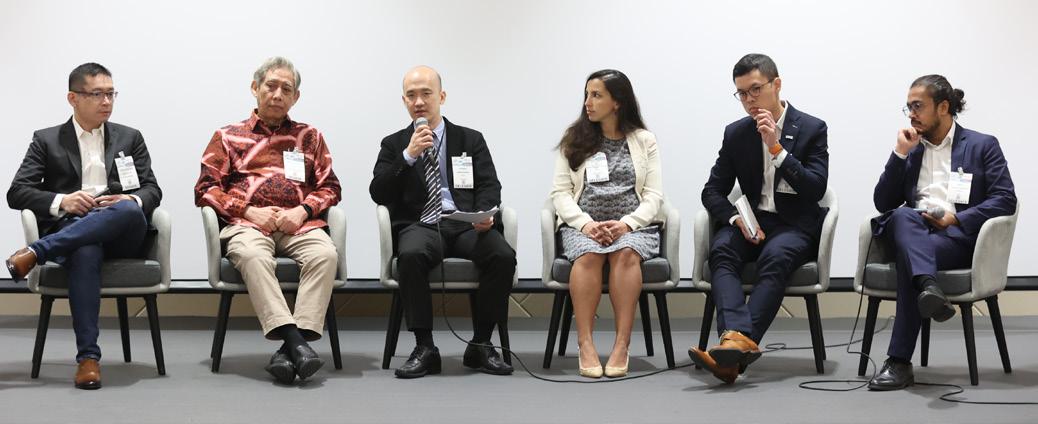


During September 15-16, APUEA hosted its new flagship event, the Asia Urban Energy Assembly, at the Queen Sirikit National Convention Center as a part of the ASEAN Sustainable Energy Week, which is ASEAN’s most comprehensive international exhibition and conference on Renewable Energy, Energy Efficiency, Environmental, and Electric Vehicle Technology. The 2-day event gathered more than 100 international district energy experts from 13 countries to listen to more than 30 different speakers and to meet and discuss and take part in the event that consisted of six sessions:
1. District Energy in the Energy Transition 2. 7th Global District Energy Climate Awards Live Edition 3. District Energy Business Models, Regulatory Frameworks, and Policies 4. District Energy Developments in the Asia-Pacific 5. District Energy Technical Solutions & Market Opportunities for APAC
6. Programme Management, Technologies, and Skills
During the event last week, APUEA and the Malaysia District Cooling Association (MDCA) signed an MoU to establish collaboration to support the development of District Cooling Systems in Malaysia and beyond. We are happy to enter into this partnership to support the development of District Cooling in Malaysia and the Asia Pacific region.

We want to thank our co-organizers ASEAN Sustainable Energy Week (ASEW), Informa Markets in Thailand, and Euroheat & Power, for creating this event with us.
We want to thank our sponsors, Qatar District Cooling Company - Qatar Cool, Danish Board of District Heating (DBDH), and HEATNET GLOBAL (Nordic Heat, Heat Academy), for supporting the event.
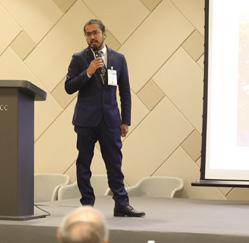


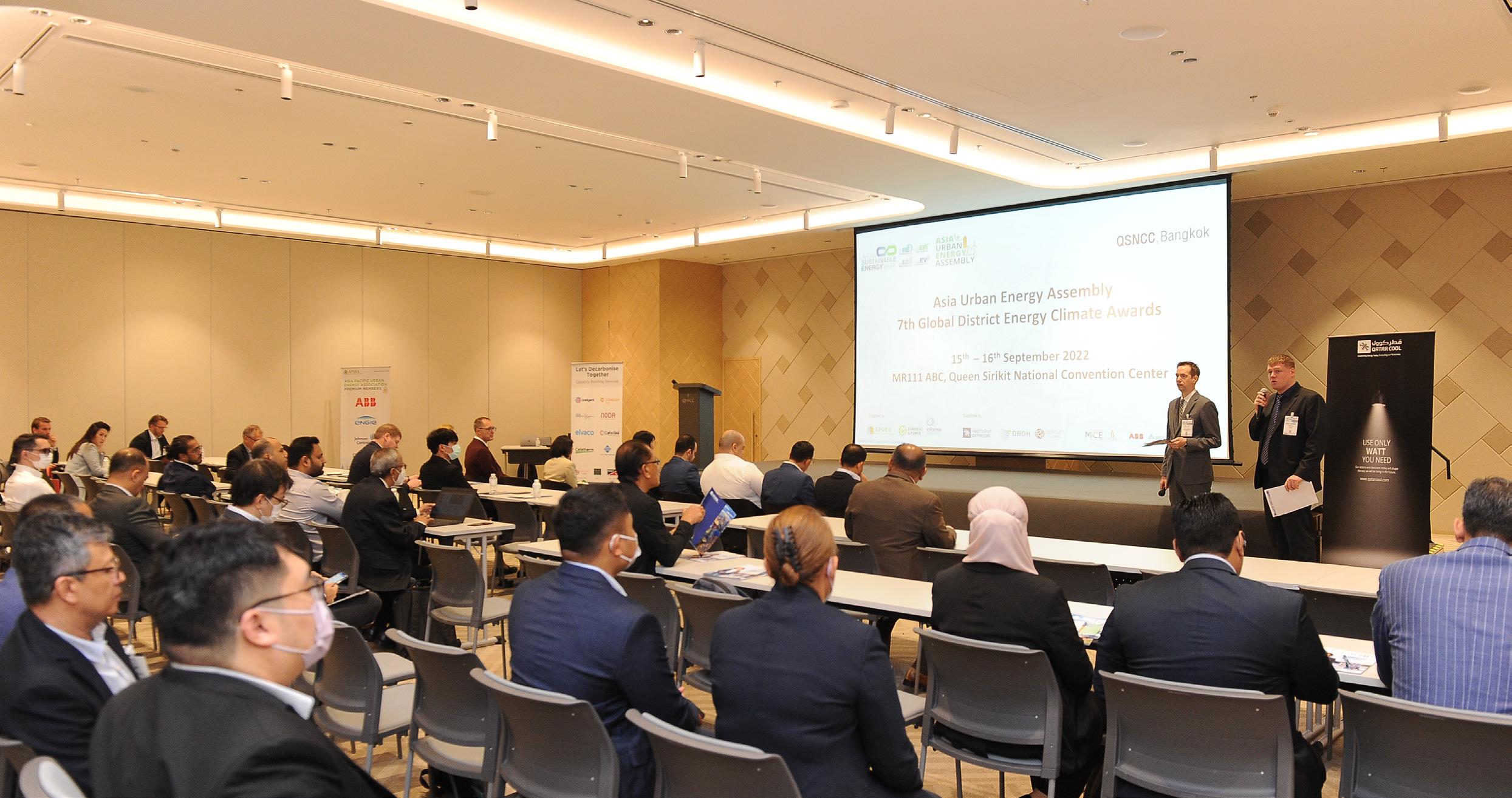
We also want to thank all speakers for your valuable



contributions:
Mikael Jakobsson, Peter Lundberg, Varnnapran Patanotai, Rungrawee Yingyuad, Ute Collier, Dr. Thaveeporn Pulket, Pär Dalin, Frank Taaning Grundholm, Mohannad Khader, Anderson Alves, Jon Thorgaard, Aurélie Beauvais, sombat Vanichprapa, Dr. Bhaskar Natarajan, Dr. Mohd Hafiz Ibrahim, Emanuele Bianco, Pongpan Vorasyan, Ts. Adrian Lim, Sudheer Perla, Rana Yusuf Nasir, Anh-Hà de FOUCAULD (DELEGUE), Isaac Ng, Helen Han, John Jakobsson, Akhil Singhal, Namtip Pornchokchai, Dr. Pipat Chaiwiwatworakul, Suneerat Fukuda, Hervé Huisman, Glyn Addicott, Chinmay Sharma, Pidchapad Kidkirdsang, James Reid, John Huang, Peter Sand, Kenth Hvid Nielsen, Rajashree Banerjee, Gary Ling KC, Peter Anderberg, Morten Jordt Duedahl.
On November 7th, APUEA hosted the “Accelerating the Energy Transition in ASEAN‘s Cities with District Cooling” workshop during the ASEAN Mechanical and Engineering Show in Kuala Lumpur, Malaysia.



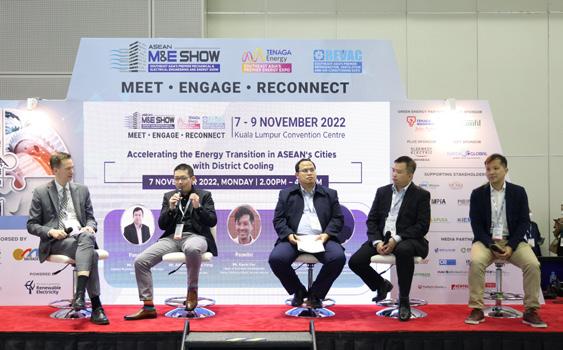




After the COP26 meeting in Glasgow last year, governments in 8 out of 10 ASEAN countries have committed to net zero targets between 2050—2065, and policymakers are currently updating energy policies to achieve these targets. District Cooling is an energy-efficient, environmentally friendly, and financially viable solution to meet the growing cooling demand and reach climate targets in ASEAN Cities.
The goal of the workshop was to:
1. Explore District Cooling as one important solution in the energy transition to achieve climate targets and to meet the growing green energy demand in ASEAN Cities.
2. Learn international best practices and regional experiences, case studies of existing and potential District Cooling projects, and different urban energy schemes, including industrial energy symbiosis and policy needs
3. Explore the design, operation, and how to invest in District Cooling projects in ASEAN countries.
It is clear that District Cooling can play a vital role in the energy transition to help ASEAN cities transition to becoming carbon neutral. There is also a huge potential to develop projects in the region, and the awareness of what benefits District Cooling systems can offer is growing rapidly!
We thank our speakers, Leo Cher (Keppel Corporation Limited), Ts. Adrian Lim (P.Tech) (KJ Engineering Sdn Bhd), Kevin Hor (ENGIE South East Asia), and Fajar Eko Antono (IFC - International Finance Corporation) for your great contribution. We also want to thank our moderator Peter Lundberg and our co-hosts, Informa Markets in Malaysia, ASEAN M&E (Official), Angeline Tang, and Shyan Tan.
On September 27th 2022, ENGIE Australia & New Zealand, ENGIE South East Asia, and Asia Pacific Urban Energy Association (APUEA) hosted the first Campus Energy Australia – Decarbonizing Universities with District Energy at Monash University in Melbourne, Australia.

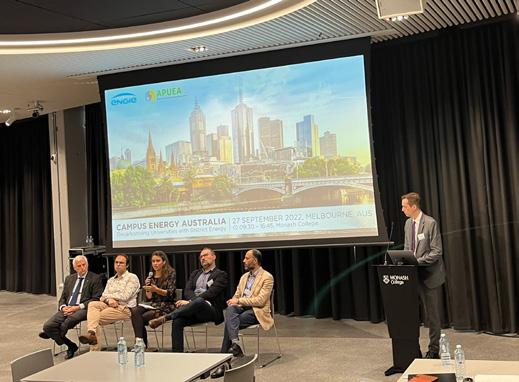


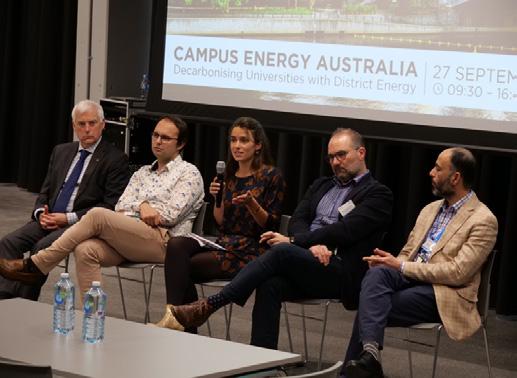
This multi-stakeholder event was intended to raise awareness of the potential of how District Energy, incl. District Heating and District Cooling can play a vital role in decarbonizing University Campuses and help to meet climate targets. With a unique knowledge of science and technology, Universities in Australia can play a vital role in the energy transition. Similar to a small city, Universities are also the perfect place to implement District Energy Systems (DCS), which can be replicated at a larger scale in other urban areas in the country.
The event gathered energy and sustainability experts from five Australian Universities and six other energy organizations to participate and network in this full-day event.
Thank you, Muhammad Ali, Anh-Hà de FOUCAULD (DELEGUE), Keith Lenghaus, Peter Lundberg, Vanessa Graham, Kendra Wasiluk, Pierluigi Mancarella, Margot Delafoulhouze, Niels Leemput, Tony Gleeson, Mathilde Godard, and Sebastien Walker for your outstanding contributions to the event!

On September 8th, APUEA hosted the workshop ”District Cooling: Accelerating Vietnam’s Transition Towards Sustainable Growth” as a part of the HVACR Vietnam show in Ho Chi Minh City, Vietnam.
During the COP26 meeting in Glasgow last year, Prime Minister Pham Minh Chinh declared that Vietnam aims to reach net-zero greenhouse gas emissions by 2050. Vietnam has announced ambitious renewable energy targets as a stepping stone to this target. It will double clean energy capacity by 31-38 GW, leading to a 15-20% share of the country’s total energy supply, mainly replacing coal, which will be phased out in the 2040s.
District Cooling is an energy-efficient, environmentally friendly, and financially viable solution to meet the growing cooling demand and reach climate targets in Vietnam.
This workshop discussed how to accelerate District Cooling developments in Vietnam to meet the growing green energy demand as a way to reach climate targets and benefit from international best practices and regional experiences.
The workshop included case studies of existing and potential District Cooling projects and different urban energy schemes, including industrial energy symbiosis and policy needs. The session also explored the design, operation, and how to invest in District Cooling projects in Vietnam, ASEAN, and Globally. We want to thank the speakers of the session, Mikael Jakobsson, BT Tee, Dr Luong Quang Huy, Adrian Lim Hock Heng, and Quan Ton, for your great contributions! We want to thank Informa Markets in Vietnam for co-hosting and helping to create this event!
On August 26th, APUEA hosted the workshop “Accelerate Optimizing your Asset Lifecycle: Best Practices in Thailand 4.0” during the MIRA Subcon EEC in Pattaya, Thailand.

As the country aims to upgrade its economic model with the Thailand 4.0 program, the Thai government has also set ambitious sustainable development targets. To fulfil their obligations, industrial companies need to optimize the lifecycle of their assets: improve energy efficiency, lower environmental impact, guarantee safety while reducing costs, and thus generate profits. To strive in the new Thailand, companies must accelerate this process.
Digitalization has already enabled improvement but has also brought confusion and disappointment: consulting firm McKinsey reports a shocking 61% failure rate for Industry 4.0 projects. Audits conducted by Asset Management specialist Siveco China in Asia confirm this finding, revealing significant gaps between strategic Asset Management needs and the actual coverage achieved by IT.
This workshop was dedicated to Thailand 4.0 and brought together a panel of high-calibre international experts with strong Thailand experience to share practical solutions for the local market.
We thank our co-hosts, Informa Markets Thailand and Siveco China, for creating this event! We also thank the session speakers Peter Lundberg, Jean Laugier, Louis Holub, Bruno Fouille, Donato Cantalupo, and Charn Saralertsophon!

On June 21st, APUEA hosted a webinar titled” Accelerating District Cooling Developments in Thailand” together with Informa Markets Thailand.
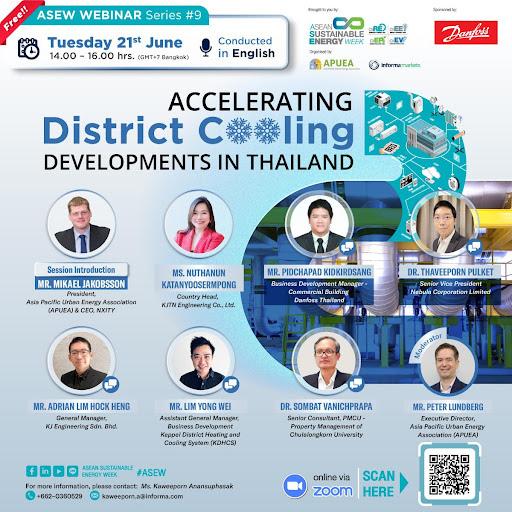
During the COP26 meeting last year, Thailand made pledges to reach carbon neutrality by 2050 and reach net-zero greenhouse gas emissions by 2065. To fulfil these pledges, Thailand is updating its Energy Master plan, with expected increased targets for Renewable Energy and Energy Efficiency.
District Cooling is getting increased attention in Thailand, both by private and public sectors, as an energy-efficient, environmentally friendly, and financially viable solution to meet the growing cooling demand and reach climate targets in the country.
This webinar discussed accelerating District Cooling developments in Thailand and benefitting from international best practices and regional experiences. The webinar included case studies of existing and potential District Cooling projects, different urban energy schemes, and policy needs.
We thank our co-hosts, Informa Markets Thailand, for creating this webinar with us! We also want to thank the session speakers, Mikael Jakobsson, Adrian Lim Hock Heng, Nuthanun Katanyoosermpong, Pidchapad Kidkirdsang, Dr Taveeporn Pulket, Lim Yong Wei, Dr Sombat Vanichprapa, and Peter Lundberg. We also want to thank Danfoss for sponsoring the session.
On June 7th, APUEA hosted an” Accelerating Vietnam’s Transition Towards Sustainable Growth” webinar with Informa Markets Vietnam.

During the COP26 meeting in Glasgow last year, Prime Minister Pham Minh Chinh declared that Vietnam aims to reach net-zero greenhouse gas emissions by 2050. Vietnam has announced ambitious renewable energy targets as a stepping stone to this target. It will double clean energy capacity by 31-38 GW, leading to a 15-20% share of the country’s total energy supply, mainly replacing coal.
District Cooling is an energy-efficient, environmentally friendly, and financially viable solution to meet the growing cooling demand and reach climate targets in Vietnam. This webinar discussed how to accelerate District Cooling developments in Vietnam to meet the growing green energy demand as a way to reach climate targets and benefit from international best practices and regional experiences.
We thank our co-hosts, Informa Markets Vietnam, for creating this webinar with us! We also want to thank the session speakers, Mikael Jakobsson, BT Tee, Dr Luong Quang Huy, Adrian Lim Hock Heng, Lim Yong Wei and Peter Lundberg.

On May 25th, APUEA hosted the” EV Charging Ecosystem in Indonesia” webinar with PT Pamerindo Indonesia, part of Informa Markets. May 25th, 2022 The webinar provided insights into the developments of EV Charging infrastructure in Indonesia.
We thank our co-hosts, PT Pamerindo Indonesia, for creating this webinar with us! We also want to thank the session speakers, Eddie Widono, Peter Lundberg, Bob Saril, Ir Riza, M. Eng Ipu, Dr Yossapong Laoonul, Yatin Premchand and Faela Sufa.

ASIA URBAN ENERGY ASSEMBLY
30 August01 September
01 - 04
MARCH
INDIA SMART UTILITY WEEK New Delhi, India 01-04 MARCH 2023
22 - 24
MARCH
PHILENERGY Manila, The Philippines 22-24 MARCH 2023
22 - 24
MAY
EUROHEAT & POWER CONGRESS Torino, Italy
Bangkok, Thailand
22-24 MAY 2023
00
JUNE
ASIA CLEAN ENERGY FORUM Manila, The Philippines JUNE 2023
25 - 27
JULY
HVACR VIETNAM Hanoi, Vietnam 25-27 JULY 2023
30 - 01
AUGUSTSEPTEMBER
ASEAN SUSTAINABLE ENERGY WEEK Bangkok, Thailand 30-01 SEPTEMBER 2023
13 - 16
SEPTEMBER
ELECTRIC & POWER INDONESIA Jakarta, Indonesia 13-16 SEPTEMBER 2023
08 - 10
NOVEMBER
DISTRICT COOLING EVENT Indonesia, TBD 08-10 NOVEMBER 2022








• Asian Development Bank (ADB)


• Asian Infrastructure Investment Bank (AIIB)

• REN21



